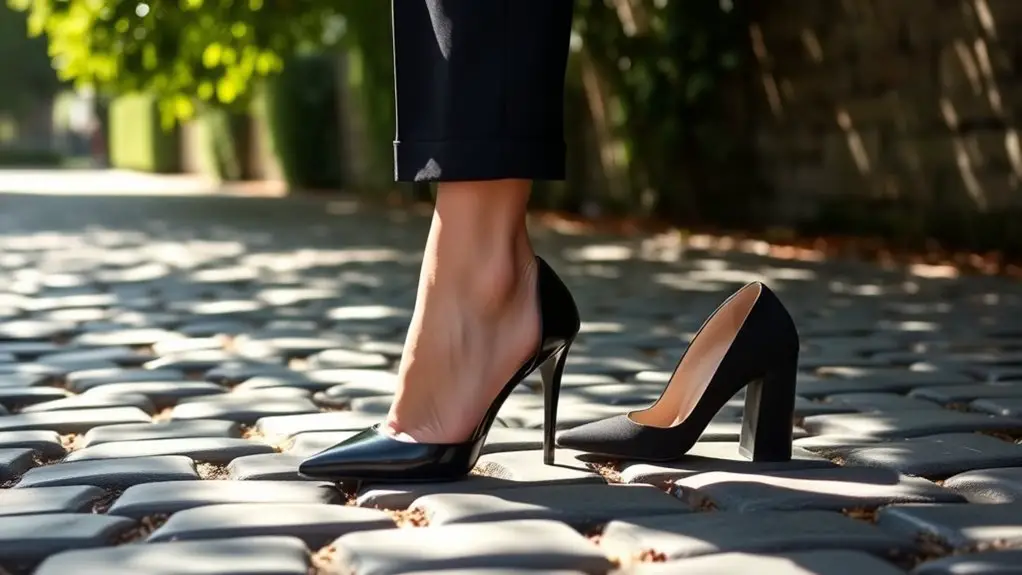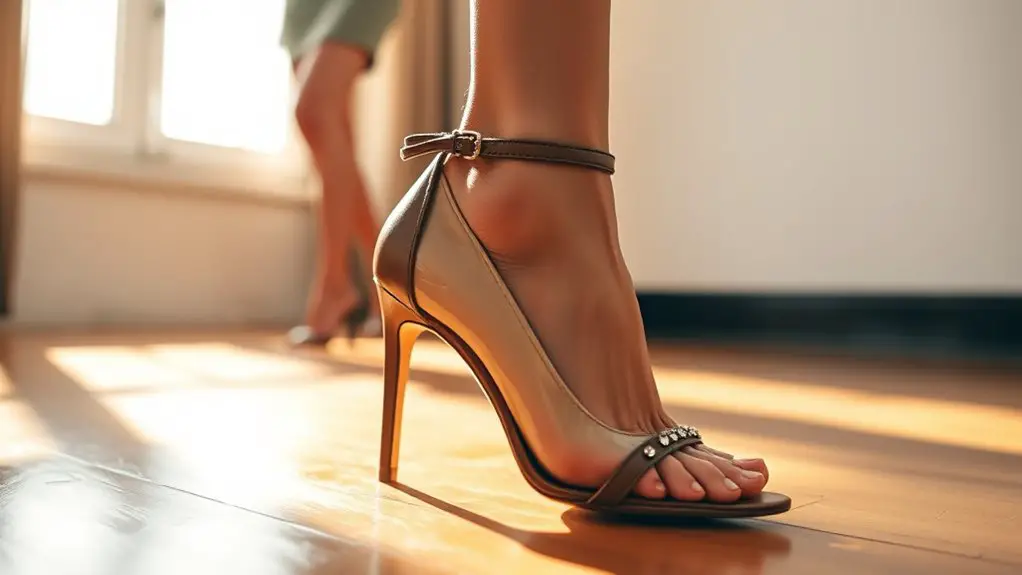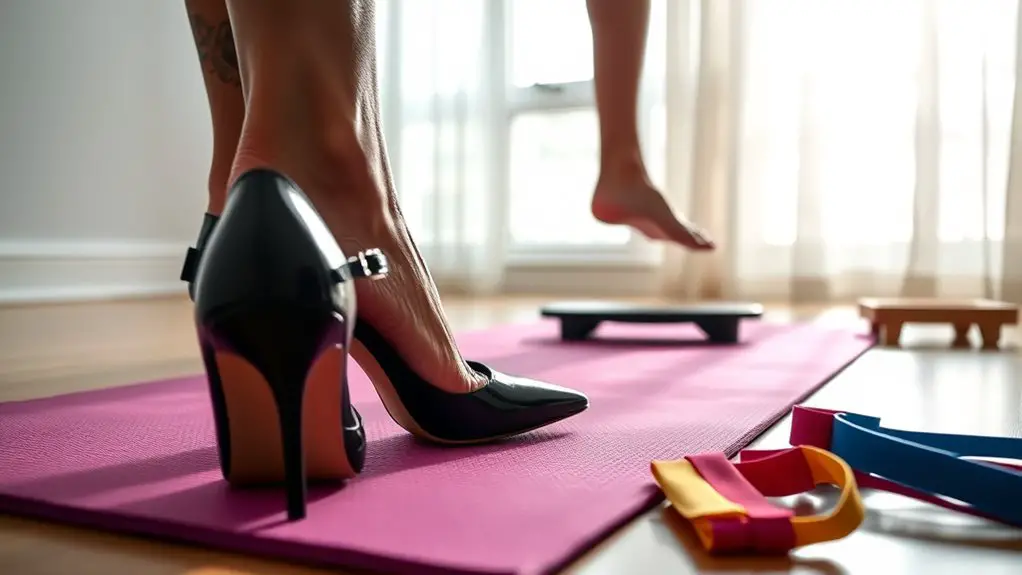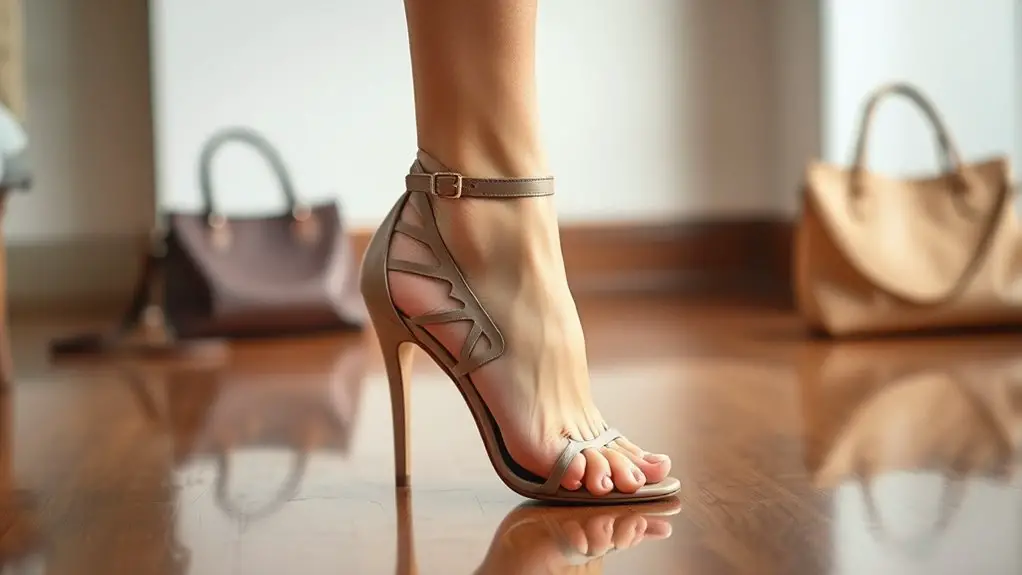To prevent twisted ankles when wearing heels, choose a moderate heel height and opt for styles with a wider base for increased stability. Select supportive materials like cushioned insoles and consider shoes with ankle straps for added security. Practice proper walking techniques by maintaining good posture and taking smaller steps. Be mindful of surface conditions, and take breaks as needed. If you follow these tips, you’ll discover even more strategies to enhance your safety in heels.
Choose the Right Heel Height

When it comes to choosing the right heel height, it’s crucial to find a balance that suits both your style and comfort. Selecting a heel height that aligns with your foot’s natural structure can greatly affect your overall foot alignment and stability. Higher heels may elevate your look, but they often compromise heel comfort and increase the risk of twisted ankles.
Aim for a heel height that allows your feet to rest naturally, ensuring your weight is evenly distributed. A moderate heel height, usually between one to three inches, provides support while still offering a touch of elegance. Remember, the more elevated the heel, the greater the impact on your foot’s alignment, which can lead to discomfort and potential injuries. Prioritize comfort alongside aesthetics to keep your feet healthy and prevent accidents, allowing you to enjoy your heels without compromising safety.
Opt for a Wider Base
When selecting heels, opting for a wider base can greatly enhance your stability and reduce the risk of twisted ankles. Wider heels not only provide better support but also come in various styles that can complement your wardrobe. Understanding the benefits and types of wider bases will help you make informed choices while maintaining your sense of style.
Benefits of Wider Heels
Choosing wider heels can greatly enhance both comfort and stability while you’re wearing heels. One of the primary wider heel advantages is the increased surface area, which helps distribute your weight more evenly. This design reduces the pressure on your feet, making prolonged wear more manageable. Additionally, wider heels provide superior fashion stability, allowing you to walk confidently without the constant worry of twisting an ankle. With better balance, you can navigate various terrains, from smooth floors to uneven surfaces, without sacrificing style. These benefits make wider heels an excellent choice for those who want to maintain a fashionable appearance while prioritizing foot health. Ultimately, opting for wider heels can transform your overall experience in stylish footwear.
Types of Wider Bases
While many people may overlook the importance of the heel’s base, opting for a wider base can greatly enhance stability and comfort. Two popular styles that offer this benefit are block heels and platform styles. Block heels feature a solid, wide base that distributes weight evenly, reducing the risk of ankle twists. They provide excellent support, making them a great choice for longer wear. On the other hand, platform styles elevate the foot while maintaining a broader base at the heel. This design not only adds height but also enhances stability, allowing you to walk with more confidence. By choosing shoes with block heels or platform styles, you’re taking a significant step towards preventing twisted ankles.
Style Versatility Considerations
Although many may prioritize aesthetics over functionality, opting for a wider heel base can offer both style versatility and enhanced stability. A wider heel not only provides better balance but also complements various outfits, making it easier to navigate different dress codes. Whether you’re dressing up for a formal event or opting for a more casual look, a wider base can adapt seamlessly to your wardrobe. You can experiment with color combinations that enhance your outfit while enjoying the peace of mind that comes with improved support. Remember, shoes that blend style with stability allow you to express your fashion sense without sacrificing comfort. Prioritizing a wider heel can elevate your overall look while keeping you grounded.
Select Supportive Materials
When selecting supportive materials for heels, it’s crucial to prioritize comfort and stability to prevent twisted ankles. Look for shoes that incorporate innovative material technologies, which can enhance flexibility while providing structure. For instance, cushioned footbeds made from memory foam or gel can offer superior shock absorption, reducing strain on your ankles.
Additionally, supportive designs often feature reinforced arches and wider soles, distributing weight evenly and improving balance. Materials like high-quality leather or synthetic blends can provide both durability and comfort, ensuring your heels withstand daily wear without compromising support.
Don’t underestimate the importance of the outsole; rubber or textured materials can enhance grip, further reducing the risk of slips. By carefully selecting heels crafted from supportive materials, you can enjoy the elegance of high heels without sacrificing your stability or risking injury.
Consider Ankle Straps

When you’re choosing heels, consider ankle straps for enhanced stability and support. They not only help secure your feet in place but also offer versatile styling options that can complement various outfits. By incorporating ankle straps, you can enjoy both fashion and functionality while reducing the risk of twisted ankles.
Enhanced Stability and Support
Ankle straps can greatly enhance the stability and support of your heels, reducing the risk of twisted ankles. By providing additional ankle stability, these straps keep your feet securely in place, allowing for confident strides. With improved heel support, you’re less likely to roll your ankle, especially on uneven surfaces.
| Benefit | Description |
|---|---|
| Enhanced Stability | Keeps your foot in place |
| Increased Comfort | Reduces pressure on the foot |
| Improved Confidence | Walk without fear of injury |
| Stylish Options | Available in various designs |
Incorporating ankle straps into your footwear not only promotes safety but also enhances your overall experience while wearing heels. Don’t underestimate the power of these simple additions!
Style Versatility Options
Though many might think of ankle straps solely for their functional benefits, they also offer impressive style versatility. You can effortlessly enhance your outfit with various style combinations, making ankle strap heels suitable for both casual and formal occasions. Whether you’re dressing up for a night out or heading to the office, these shoes can elevate your look.
Additionally, ankle straps come in a multitude of color variations, allowing you to find the perfect match for any ensemble. Classic black or nude options provide timeless elegance, while bold colors or patterns can make a statement. By incorporating ankle straps into your wardrobe, you can enjoy both stability and style, ensuring you look chic without sacrificing comfort.
Practice Walking Techniques
Practicing effective walking techniques is essential for anyone looking to navigate the challenges of wearing heels confidently. Start by focusing on your walking posture. Stand tall with your shoulders back, engaging your core to provide support. This alignment helps distribute your weight evenly and reduces the risk of twisting your ankle.
Next, pay attention to heel positioning. When you step, place your heel down first, followed by the ball of your foot. This technique creates a natural rolling motion that stabilizes your foot. Try to maintain a straight line as you walk, keeping your feet hip-width apart to enhance balance.
Additionally, practice walking on different surfaces, like grass or carpet, to adapt to varying terrains. Take smaller, controlled steps to maintain stability and reduce the likelihood of missteps. By honing these techniques, you’ll boost your confidence and markedly lower the chances of ankle injuries while wearing heels.
Strengthen Your Ankles

Strengthening your ankles is essential for preventing injuries while wearing heels. Incorporating balance exercises, resistance training, and a flexibility routine can greatly enhance your ankle stability and overall foot health. By focusing on these key areas, you’ll build a solid foundation that supports your stride.
Balance Exercises Importance
As you navigate the challenges of wearing heels, incorporating balance exercises into your routine can greatly enhance ankle stability. Balance training isn’t just about standing on one leg; it’s about engaging your entire body, particularly your core stability. Strong core muscles support better alignment and control, essential for maintaining balance in heels. Simple exercises like single-leg stands or stability ball work can greatly strengthen your ankles and improve proprioception. This heightened awareness of your body’s position helps prevent twisted ankles, allowing you to walk confidently. By dedicating time to balance exercises, you’re not only fortifying your ankles but also enhancing overall body coordination, making your experience in heels much safer and more enjoyable.
Resistance Training Benefits
Building on your commitment to balance exercises, resistance training can play a pivotal role in strengthening your ankles. By incorporating targeted exercises, you’ll enhance your ankle stability, which is essential for injury prevention when wearing heels. Here’s a quick overview of key resistance training benefits for your ankles:
| Benefit | Description |
|---|---|
| Increased Strength | Builds muscle around the ankle joint. |
| Better Stability | Improves overall balance and coordination. |
| Enhanced Flexibility | Helps maintain range of motion. |
| Reduced Injury Risk | Strengthens ligaments to prevent sprains. |
| Improved Posture | Supports alignment while wearing heels. |
Flexibility Routine Essentials
To effectively strengthen your ankles and reduce the risk of injury while wearing heels, incorporating a flexibility routine is crucial. Focus on targeted flexibility exercises that enhance ankle mobility and stability. Begin with calf stretches and ankle circles to loosen tight muscles and improve range of motion. Incorporate toe raises and heel drops to strengthen the muscles that support your ankles. Additionally, consider using resistance bands for lateral ankle stretches, which can further enhance flexibility and stability. It’s essential to practice these stretching techniques consistently, ideally daily, to achieve optimal results. By committing to a flexibility routine, you’ll not only strengthen your ankles but also increase your confidence when walking in heels, minimizing the risk of twisted ankles.
Use Cushioned Insoles
Cushioned insoles can be a game changer for anyone who frequently wears heels. By choosing the right cushion types, you can greatly enhance comfort and stability. These insoles often come in various materials, such as gel or foam, providing targeted support to the arch and ball of your foot.
One of the key insole benefits is that they help absorb shock, reducing the impact on your feet as you walk. This can minimize fatigue and discomfort during long hours of wear. Additionally, cushioned insoles promote better foot alignment, which can help prevent twisting and rolling of the ankle.
When selecting insoles, look for options specifically designed for heels, as they can offer extra cushioning where you need it most. Incorporating cushioned insoles into your favorite pairs can make a notable difference, allowing you to enjoy wearing heels without the worry of injury.
Be Mindful of Surface Conditions
While it might be tempting to wear your favorite heels anywhere, being mindful of surface conditions is essential for preventing twisted ankles. Uneven surfaces, such as cobblestones or gravel, can greatly increase your risk of losing your balance. When traversing these terrains, take smaller, more deliberate steps to maintain stability.
Additionally, be cautious of slippery conditions, whether they’re caused by rain, spills, or polished floors. In such cases, it’s wise to avoid heels altogether or choose styles with better traction. If you must wear heels in these environments, look for shoes with a thicker heel or textured sole to enhance grip.
Always scan your surroundings before walking; being aware of potential hazards can help you avoid accidents. By paying attention to surface conditions, you can enjoy your heels while keeping your ankles safe and secure.
Take Breaks When Needed
Taking breaks when needed is crucial for preventing twisted ankles, especially when wearing heels for extended periods. Your ankle health can notably decline if you don’t give your feet a chance to rest. Prolonged wear can lead to fatigue and a higher risk of injury. Make it a habit to take short breaks, allowing your feet to recover while minimizing stress on your ankles.
During these breaks, consider switching to heel alternatives, like stylish flats or supportive sneakers, which can provide much-needed relief. This not only helps prevent twisting but also promotes better overall foot health.
If you’re attending an event, plan moments where you can sit or walk barefoot if possible. By being proactive about breaks and exploring heel alternatives, you’re taking crucial steps to safeguard your ankle health while enjoying fashionable footwear. Remember, your comfort and safety should always come first!
Know When to Say No to Heels
Have you ever considered whether certain occasions warrant a break from heels? It’s important to evaluate the settings where you’ll be wearing them. If you’re attending an event that involves a lot of standing or walking, think about choosing heel alternatives like stylish flats or supportive block heels. These options can help maintain ankle safety while still looking chic.
Additionally, consider the terrain. If you’ll be outdoors on uneven surfaces, it’s wiser to skip the heels altogether. Remember, sacrificing style for comfort doesn’t mean you can’t look good. Opt for fashionable sneakers or dressy sandals that provide stability and support.
Ultimately, knowing when to say no to heels is vital for your overall well-being. Prioritizing ankle safety can prevent injuries and guarantee you enjoy your time, whether at a formal event or a casual outing. Make informed choices that keep your feet happy!
Frequently Asked Questions
Can I Wear Heels if I Have a History of Ankle Injuries?
If you’ve sprained your ankle before, wearing heels might be risky. Consider options with ankle support or heel alternatives like wedges. Prioritize comfort and stability to avoid further injury while still looking stylish.
What Types of Heels Are Best for Stability?
For stability, you should consider block heels or wedge heels. These styles provide a wider base, distributing weight evenly and reducing the risk of ankle twists, making them a safer choice for your footwear collection.
How Can I Make My Heels More Comfortable?
To make your heels more comfortable, consider adding heel padding for extra cushioning and ensuring proper arch support. These adjustments can considerably enhance comfort, allowing you to wear your heels longer without discomfort or pain.
Are There Exercises to Improve Balance for Wearing Heels?
Yes, there are effective balance exercises to enhance ankle stability. Incorporate single-leg stands, toe raises, and balance boards into your routine. These will strengthen your ankles and improve your overall stability when wearing heels.
Is It Safe to Wear Heels on Uneven Surfaces?
Heels on uneven surfaces? It’s hazardous! High heel height can hinder stability, while insufficient surface traction heightens the risk of slips. If you must, choose lower heels and guarantee solid footing for safety’s sake.



